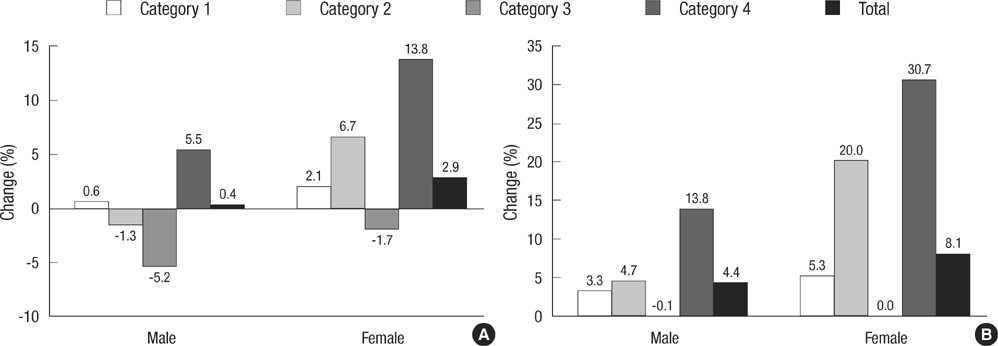J Korean Med Sci.
2010 Dec;25(Suppl):S13-S19. 10.3346/jkms.2010.25.S.S13.
Current Status of Pneumoconiosis Patients in Korea
- Affiliations
-
- 1Occupational Lung Diseases Institute, Ansan, Korea. cbsoon@chol.com
- KMID: 1714062
- DOI: http://doi.org/10.3346/jkms.2010.25.S.S13
Abstract
- This study identifies the number of pneumoconiosis patients after eliminating deceased patients between 2003 and 2008 as of January 1st and estimates it for the next five years. From 2003 to 2008, the pneumoconiosis patients were 16,929, 17,224, 17,366, 17,566, 17,542, and 17,546, respectively. The number of pneumoconiosis patients will have increased by 1,014 from 2008 to 18,560 in 2013 after applying the average change rates taken from 2003 to 2007. It takes 15-20 yr to develop coal workers' pneumoconiosis (the main cause in Korea) and patients will continue to be diagnosed with pneumoconiosis for some years to come since it has only been 20 yr since the decline of the coal mining industry in Korea. In addition, pneumoconiosis patients are increasing in industries in which the risk of pneumoconiosis was relatively low shows the necessity to improve dust-exposed workplace environments.
Keyword
MeSH Terms
Figure
Reference
-
1. Choi BS. Status and measures of pneumoconiosis. J Korean Med Assoc. 1997. 40:609–615.2. Ogawa S, Imai H, Ikeda M. A 40-year follow-up of whetstone cutters on silicosis. Ind Health. 2003. 41:69–76.3. Mohebbi I, Zubeyri T. Radiological progression and mortality among silica flour packers: a longitudinal study. Inhal Toxicol. 2007. 19:1011–1017.4. Park HH, Girdler-Brown BV, Churchyard GJ, White NW, Ehrlich RI. Incidence of tuberculosis and HIV and progression of silicosis and lung function impairment among former Basotho gold miners. Am J Ind Med. 2009. 52:901–908.5. Kimura K, Ohtsuka Y, Kaji H, Nakano I, Sakai I, Itabashi K, Igarashi T, Okamoto K. Progression of pneumoconiosis in coal miners after cessation of dust exposure: a longitudinal study based on periodic chest X-ray examinations in Hokkaido, Japan. Intern Med. 2010. 49:1949–1956.6. Choi BS, Choi JK, Kim SJ, Lim Y, Ko JW, Jung HC, Cheon YH, Jin Y, Kim JH, Bae GR. The relationship between pneumoconiosis and lung cancer. 1999. Gwacheon: The Ministry of Labor;12–20.7. Choi BS. Lung cancer risk of pneumoconiosis among miners (I). 2002. Incheon: Occupational Safety and Health Research Institute;15–25.8. Choi BS. Lung cancer risk of pneumoconiosis among miners (II). 2004. Incheon: Occupational Safety and Health Research Institute;15–27.9. Choi BS, Kim BW. Development of statistical system for analysis of occupational lung diseases. 2006. Ansan: Center for Occupational Lung Diseases;16–58.10. Choi BS. Development of coalworkers' pneumoconiosis in Korea: risk factors and incidence density. Korean J Occup Environ Med. 1996. 8:137–152.11. Choi BS. A study on the development of coalworkers' pneumoconiosis in Korea. 1995. Seoul: Graduate School of Health, Seoul National University;69–70.
- Full Text Links
- Actions
-
Cited
- CITED
-
- Close
- Share
- Similar articles
-
- A Case of Caplan`s Syndrome with Pulmonary Tuberculosis
- A Post-examination Health Care Status of Workers with Pneumoconiosis in Manufacturing Factories
- The Perceived Social Support of the Family with Pneumoconiosis Patient
- Comparison of Epidemiologic Characteristics of Pneumoconiosis in Manufacturing and Mining Industries in Korea
- Life Satisfaction, Social Support, Perceived Health Status, and Loneliness of the Hospitalized Patients with Pneumoconiosis




